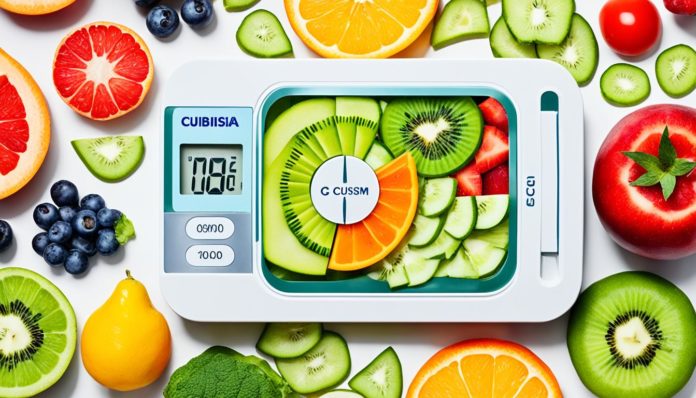Did you know nearly one in four people with diabetes don’t know they have it? Spotting the early signs is crucial. It can greatly improve your health by catching diabetes early. This means you can avoid serious problems.
Look out for these symptoms: feeling hungrier than usual, losing weight without trying, having to pee often, drinking more water, feeling tired, having a dry mouth, itchy skin, and not seeing clearly. Symptoms can be different for each person. Type 1 diabetes signs show up fast. But, Type 2 diabetes takes time and might not be as obvious.
Key Takeaways
- Nearly one in four people with diabetes are undiagnosed.
- Early detection of diabetes can remarkably enhance health outcomes.
- Common diabetes warning signs include frequent urination, excessive thirst, and increased hunger.
- Type 1 diabetes symptoms tend to appear quickly, whereas Type 2 diabetes develops more gradually.
- Recognizing the early signs of diabetes can help prevent severe health complications.
What is Diabetes?
Diabetes is a chronic condition where blood glucose levels are too high. The issue mostly comes from the body’s struggle with insulin. Insulin helps manage blood sugar. There are two main types of diabetes, and each affects the body differently.

Definition and Types
Type 1 diabetes results from the body not making enough insulin. It often starts in kids and young adults. Without insulin, managing blood glucose is hard. Meanwhile, type 2 diabetes stems from insulin resistance. The body does make insulin but can’t use it well. It’s more common in adults and linked to lifestyle choices.
Impact on the Body
Diabetes can harm the body in many ways. Over time, high blood sugar can hurt organs and systems. Issues like heart problems, nerve damage, and kidney disease can occur. Knowing your diabetes type and symptoms is key. This helps in managing the disease and avoiding bigger health problems.
Frequent Urination and Thirst
One of the early signs of diabetes includes frequent peeing and immense thirst. This happens when your blood sugar is high. It makes the kidneys work extra hard.

Why It Happens
When your blood sugar goes up, your kidneys can’t keep up. They can’t reabsorb all the sugar. So, they have to get rid of it through your pee. This makes you go to the bathroom more often.
How It Feels
Having to pee a lot can really interrupt your day and night. It can wake you up many times. Then, you end up feeling really thirsty because your body is losing water.
When to Seek Help
If these signs, like peeing a lot and being very thirsty, don’t go away, it’s important to see a doctor. If these keep happening with other diabetes signs, your body might be having a tough time handling sugar.
Increased Hunger and Fatigue
Diabetes can lead to more hunger and consistent fatigue, which are signs of the condition. This happens because the body can’t use glucose well, leaving you low on energy. When cells don’t get energy, your body wants more food to make up for it.
In women, as diabetes symptoms get worse, it’s harder for muscles and organs to get the energy they need. This causes unusual tiredness. Even if you rest well, you might still feel tired.
Knowing these signs is key to catching diabetes early and dealing with it. If you’re always hungry even when eating normally, and you’re always tired without working hard, it’s time to see a doctor.
Below is a table that shows how a lack of insulin affects hunger and tiredness:
| Impact | Description |
|---|---|
| Increased Hunger | Body compensates energy deficit through heightened hunger levels. |
| Fatigue | Muscles and organs receive less energy, leading to continuous tiredness. |
| Energy Deprivation | Insulin inefficiency causes cells to starve, impacting overall energy levels. |
Unexpected Weight Loss
Seeing unexpected weight loss can be worrying. It may mean something serious, especially if it happens all of a sudden. This often happens without dieting or increasing exercise. When this occurs, it’s a strong sign of diabetes, pointing to issues like type 1 or type 2 diabetes.
Type 1 Diabetes Impact
With type 1 diabetes, your body can’t make insulin. So, it uses fat and muscle for energy, not glucose. This leads to significant weight loss. People with type 1 diabetes can lose weight quickly, even if they eat more.
Type 2 Diabetes Impact
Type 2 diabetes can also cause unexpected weight loss, but it’s rarer. Here, the body makes too little insulin or can’t use it right. This makes it hard to use glucose for energy, leading to weight loss. This symptom, though less common, still hints at type 2 diabetes. It’s a warning sign if you also feel hungrier or more tired than usual.
| Diabetes Type | Impact on Weight | Other Symptoms |
|---|---|---|
| Type 1 Diabetes | Significant, rapid weight loss | Frequent urination, thirst, fatigue, increased hunger |
| Type 2 Diabetes | Occasional, mild weight loss | Blurred vision, fatigue, increased infections |
Blurred Vision and Eye Difficulties
Blurred vision may be a sign of diabetes, due to changes in fluid levels. These changes can affect how the eyes’ lens shapes, impacting focus. If you notice constant blurriness, vision loss, or dark spots, it’s crucial to see a healthcare provider. These signs could point to diabetes.
Diabetic eye disease includes diabetic retinopathy, cataracts, and glaucoma. These issues come from high blood sugar harming the eyes’ blood vessels. To prevent them, it’s key to have regular eye exams and keep blood sugar in check.
Keeping blood pressure and cholesterol low helps avoid eye problems. Quitting smoking also helps. If you notice sudden changes in vision or the retina detaching, seek medical help right away.
| Eye Conditions | Causes | Prevention |
|---|---|---|
| Diabetic Retinopathy | High blood glucose levels | Regular eye exams, managing diabetes |
| Cataracts | Lens clouding | Controlling blood sugar levels, eye exams |
| Glaucoma | Increased eye pressure | Monitoring eye pressure, regular check-ups |
Diabetic eye disease symptoms include blurry vision and seeing dark spots. Poor color vision is another warning sign. These signs should lead you to consult an eye specialist immediately. They can suggest treatments like medication, laser therapy, or surgery. It’s all about taking care of your eyesight.
Dry Mouth and Skin Issues
One less known sign of diabetes in adults is a dry mouth. This happens because the body tries to remove extra blood sugar through urination. This can cause dehydration, making the mouth feel dry.
People might also see skin problems as early diabetes signs in women. The skin may get very dry and itchy because of fluid loss. This makes the skin lose moisture, causing dryness and possible chapping.
Paying attention to signs like a dry mouth and skin problems is vital. Not having enough water affects your health and makes it hard for the skin to stay soft. Spotting these signs early can help you get medical advice and manage the condition better.
Slow-Healing Wounds
Slow-healing wounds are a major worry for people with diabetes. High blood sugar, poor circulation, and diabetic neuropathy slow down healing. It’s important to know how these factors affect wound healing.
Interference with Healing
High blood sugar can weaken white blood cells that fight off infections. Poor circulation makes healing even tougher. This means wounds take longer to heal. Spotting these signs early can hint at diabetes or prediabetes.
Potential for Infections
Diabetes makes it easier to get infections from wounds that heal slowly. Without treatment, these wounds can lead to more serious issues. Because of diabetic neuropathy, it’s hard to feel injuries, which can get worse unnoticed. Proper wound care is key to avoiding these problems.
Common Diabetes Signs and Symptoms in Adults and Children
Knowing the early signs of diabetes early can greatly help in managing it. These signs are mostly the same for all ages. But, they do vary slightly between adults and kids. Knowing these signs can lead to early help and treatment.
- Extreme hunger
- Frequent urination
- Tiredness
- Blurred vision
In the case of children, they show similar symptoms. Yet, they also have unique signs of their own. These include:
- More vaginal yeast infections in prepubescent girls
- Symptoms linked to obesity like skin darkening and more infections
Anyone, whether adult or child, who notices symptoms of type 2 diabetes should get medical help. Acting quickly is key to managing the disease well. This can avoid more serious problems later on.
Conclusion
It’s very important to know the early diabetes signs and symptoms. This can include being very thirsty, feeling hungrier, losing weight without trying, and more. Knowing these can help you get advice and care quickly. This helps a lot with better handling diabetes.
Living a healthy life is key in avoiding and controlling diabetes. You should eat healthy, exercise often, and keep an eye on your blood sugar. Doing these things can lessen your diabetes risk or help you manage it if you have it. This way, you can stay healthier and avoid more problems.
Seeing a doctor often is crucial, especially if diabetes runs in your family or if you’re more likely to get it. Getting checked regularly can catch diabetes early and make handling it much better. By being aware of diabetes signs and symptoms, you can take good care of your health. This helps you aim for a healthier future.
FAQ
What are the early signs of diabetes?
Early signs of diabetes include increased hunger and unexpected weight loss. People may also pee a lot, feel very thirsty, and get tired easily. Other signs are a dry mouth, itchy skin, and not seeing clearly.
What is diabetes?
Diabetes is when blood sugar is too high because of insulin issues. Type 1 diabetes means not enough insulin is made. In Type 2, the body doesn’t use insulin right. Both types make blood sugar levels go up.
How does diabetes impact the body?
Diabetes makes blood sugar high, which can harm many parts of the body. It can mess up blood flow, blur vision, slow down wound healing, and make infections more likely.
Why do people with diabetes experience frequent urination and thirst?
High blood sugar makes kidneys work harder, causing more pee. This leads to losing more water, making you very thirsty.
How does frequent urination feel for someone with diabetes?
It means needing to pee a lot, even at night. You might feel really thirsty and have a dry mouth too.
When should someone seek help for frequent urination and thirst?
If peeing a lot and feeling thirsty don’t stop, especially with other diabetes signs, it’s key to get medical help.
What causes increased hunger and fatigue in diabetes?
Not enough energy reaches cells because of insulin problems. The body wants more food for energy, but still feels tired since organs and muscles aren’t getting enough fuel.
How does unexpected weight loss relate to type 1 diabetes?
In type 1 diabetes, the body uses muscle and fat for energy since there’s no insulin. This leads to losing weight without trying, which is a big warning sign.
Is unexpected weight loss common in type 2 diabetes?
Weight loss happens in type 2 diabetes, but it’s not as common or severe as in type 1. Still, if weight changes with other symptoms, see a doctor.
What causes blurred vision in diabetes?
Fluid shifts change the shape of the lens in the eyes, making it hard to focus. See a doctor if your vision stays blurry or gets worse.
Why do diabetics often experience dry mouth and skin issues?
Peeing a lot can make you dehydrated, leading to a dry mouth. Your skin might also be dry and itchy. Watching for these helps catch diabetes early.
How does diabetes interfere with wound healing?
Sugar in the blood can make it hard for blood to move and slows down white blood cells. This means wounds heal slowly, raising the risk of infection.
What is the potential for infections in diabetics?
Diabetics are more prone to infections because their white blood cells don’t work right and wounds heal slowly. Nerve damage can also make infections worse if not treated early.
What are common diabetes signs and symptoms in adults and children?
Adults and kids can feel very hungry, pee a lot, get tired, and have blurry vision. Preteen girls might get yeast infections. Overweight kids have a higher diabetes risk and may show skin darkening and frequent infections.


